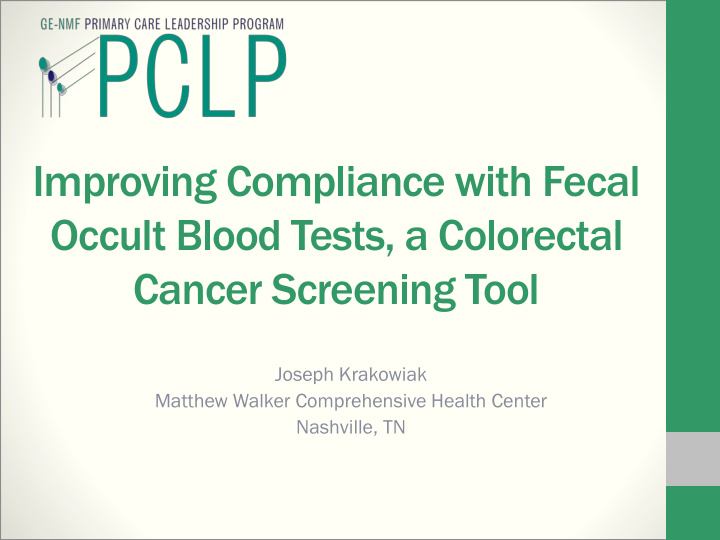



Improving Compliance with Fecal Occult Blood Tests, a Colorectal Cancer Screening Tool Joseph Krakowiak Matthew Walker Comprehensive Health Center Nashville, TN
Introduction • National avg rate of CRC screening for 0-138% poverty line= 49.8% 8% (USDHHS, 2010) • Rate of CRC screening at MWCHC in 2012 = 31% 1% (MWCHC UDS Report, 2012) • This pilot study focused on improving the rate of CRC screening at MWCHC with specific focus on Fecal Occult Blood Tests (FOBT)
Background • CRC is 2 nd leading cancer killer in U.S. • TN has high CRC death rate (17.1-21.5%) and low screening rate (59.3-63.5%) 1 • If everybody 50 or older had regular screening tests, 60% of deaths from CRC could be prevented • Current guidelines for screening: ages 50-75 • FOBT 1x/year, • Sigmoidoscopy every 5 years with FOBT every 3 years, OR • Colonoscopy every 10 years • FOBT is less expensive and non-invasive • Many studies have been done to increase FOBT compliance – some have succeeded, others have not 2,3,4,5 • Multiple studies link higher FOBT compliance with self-efficacy, CRC knowledge, and physician recommendation 3,4 1. Centers for Disease Control and Prevention. Colorectal (Colon) Cancer. Retrieved from www.cdc.gov/cancer/colorectal on July 28, 2013. 2. Vernon SW. Participation in colorectal cancer screening: a review. J Natl Cancer Inst . 1997;89:1406-22. 3. Friedman LC, Everett TE, Peterson L, Ogbonnaya KI, & Mendizabal V (2001). Compliance with fecal occult blood test screening among low-income medical outpatients: A randomized controlled trial using a videotaped intervention. Journal of Cancer Education , 16(2), 85-8. 4. Friedman LC, Webb JA, Everett TE (2004). Psychosocial and medical predictors of colorectal cancer screening among low-income medical outpatients. Journal of Cancer Education . 19: 180-186. 5. Wolf RL, Zybert P, Brouse CH, et al. (2001). Knowledge, beliefs, and barriers relevant to colorectal cancer screening in an urban population: a pilot study. Fam Community Health . 24(3): 34-47.
Methodology Total # patients 50-85 at MWCHC in 2012 N = 6951 Barrier Intervention 1) Patient difficulty to Development and Total # patients successfully complete and distribution of simple return the screening test instruction sheet for the reasonable to screening test recommend FOBT 2) Lack of physician Strategic placement of N = ? reminders to recommend reminder cards urging CRC screening when physicians to offer a CRC appropriate screening if necessary Total # patients given 3) Lack of patient awareness Distribution of educational FOBT of CRC screening posters as part of a CRC N = ? recommendations and screening awareness options campaign Total # patients ? completed FOBT Where is N = ? the largest drop-off?
Methodology (cont.)
Results • 10/10 patients who read the FOBT instructions sheet agreed that it was easy to understand and that it would help them perform and complete the FOBT screening • Final results on CRC compliance will not be available until the 2013 UDS Report is completed
Discussion • FOBT instructions are at appropriate reading level • Reminders are helpful to providers • IT is currently working on creating a pop-up reminder in patient charts for preventive screenings due • Effect on CRC compliance is TBD • Some obstacles identified were excluded from intervention due to time and resources • There are several other obstacles that could be targeted in future studies (Ex. – returning FOBT samples)
Recommendations • Keep using the FOBT instructions! • Help patient navigate the resources • Make sure exam rooms are stocked with bags of materials • Print/copy instructions as necessary • Develop a system to help patients return FOBT samples in a convenient and timely manner • Get envelopes for patients to mail them back, or • Remind patients a week before their next appointment to collect the samples • Increase patient awareness about screening via closed circuit television if possible, or through educational seminars • Consider demonstrating the screening test with the patient
Conclusion • Increasing facility of completing FOBT screening for the patient and increasing facility of recommending FOBT screenings for providers could dramatically increase the number of low- income and uninsured patients who are adequately screened for CRC – could save many lives. • The effect of the three-pronged approach used in this study on CRC screening rate is still pending • Many future directions and recommendations have been borne out of this study • Many other avenues can be explored to increase CRC compliance
Acknowledgements Dr. Ida Michele Williams Dr. Carol Freund Nicoll Hannaway, LCSW Charlene Coplen, RN Robin Dean Karen DeBerry Jeffrey McKissack, CEO MWCHC physicians, nurses, MAs, and staff GE Foundation National Medical Fellowships Primary Care Leadership Program
Recommend
More recommend